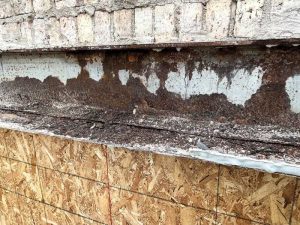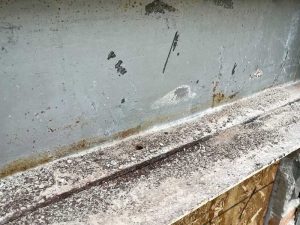Failures: School corrosion underscores documentation importance
by arslan_ahmed | October 5, 2023 5:47 pm
 [1]
[1]A recent investigation of a 1950s multi-story school building in the Midwest began after a moment of panic by school administrators. The building is constructed with a steel structural frame, with bar joists for support of floor and roof slabs bearing on beams at the exterior wall. At the exterior walls, masonry infill is present between steel members. The building is clad with a brick and limestone veneer. Corrosion of steel was observed at the head of window openings, with localized displacement of the adjacent masonry veneer. In at least one location, the steel had deflected downward a sufficient distance to make contact with and cause distortion of the aluminum-framed window system below. The inspector who performed the initial inspection expressed concern that the observed deterioration and deflection had compromised the structural integrity of the overall building frame. The school administration was advised to evacuate the building until shoring could be installed or repairs could be completed.
Since no drawings survived showing the original 1950s design, further investigation began with inspection openings at locations of displaced brick masonry to document the actual dimensions and configuration of the structural steel assembly. As built, the primary steel beam at the exterior wall included a secondary steel lintel plate spot welded to the bottom flange. The lintel plate supported the masonry veneer. In some areas the lintel plates had corroded, with pack rust developing between the plate and the beam flange, resulting in localized downward deflection of the lintel plate between welds. Structural analysis showed the primary steel beams retained ample capacity to support the imposed loads and that no shoring was required. Even with the significant localized corrosion and distortion observed at the lintel plates, the steel plates retained sufficient section to be repaired in place by removal of pack rust, installation of supplemental fasteners, and priming and painting. To accommodate the lintel work and install a new flashing system, localized rebuilding of the masonry veneer was necessary.
 [2]
[2]In existing buildings, it can be challenging to understand the significance of observed distress conditions. Sometimes seemingly minor flaws are indicative of potentially significant conditions, while in other instances even severe corrosion and displacement are revealed to represent only localized problems once the configuration and original design of the structure are understood. Building professionals need to proceed with caution, but it is important to begin by documenting the actual configuration of the original assemblies and understanding how they are meant to function. Only then can the relative significance of an observed problem be determined.
 Kenneth Itle, AIA, is an architect and associate principal with Wiss, Janney, Elstner Associates (WJE) in Northbrook, Illinois, specializing in historic preservation. He can be reached at kitle@wje.com.
Kenneth Itle, AIA, is an architect and associate principal with Wiss, Janney, Elstner Associates (WJE) in Northbrook, Illinois, specializing in historic preservation. He can be reached at kitle@wje.com.
 Mike Ford is an architect and senior associate with Wiss, Janney, Elstner Associates (WJE) in Northbrook, Illinois. He specializes in facade assessment and repair. He can be reached at mford@wje.com.
Mike Ford is an architect and senior associate with Wiss, Janney, Elstner Associates (WJE) in Northbrook, Illinois. He specializes in facade assessment and repair. He can be reached at mford@wje.com.
The opinions expressed in Failures are based on the authors’ experiences and do not necessarily reflect that of The Construction Specifier or CSI.
- [Image]: https://www.constructionspecifier.com/wp-content/uploads/2023/10/Figure-1.jpg
- [Image]: https://www.constructionspecifier.com/wp-content/uploads/2023/10/Figure-2.jpg
Source URL: https://www.constructionspecifier.com/failures-school-corrosion-underscores-documentation-importance/